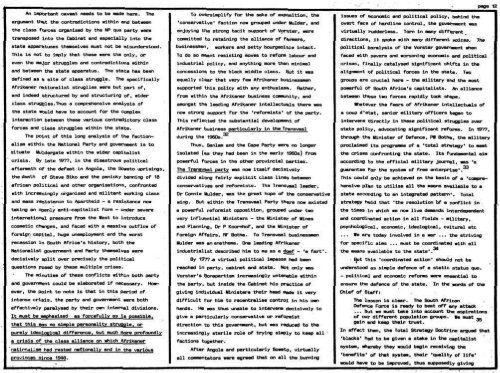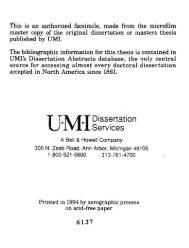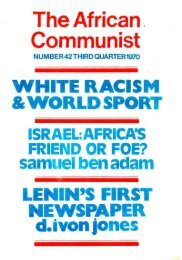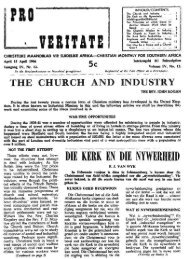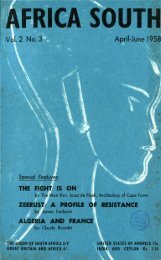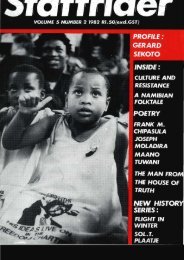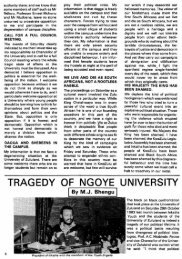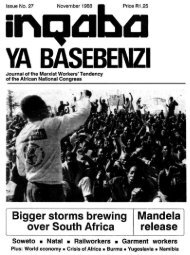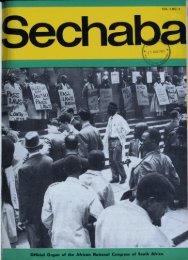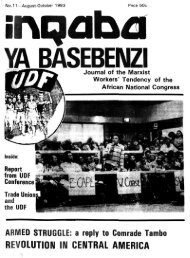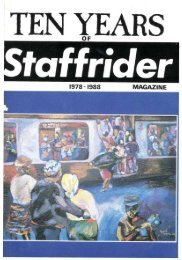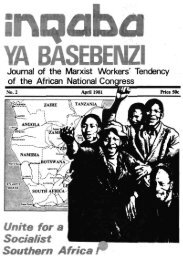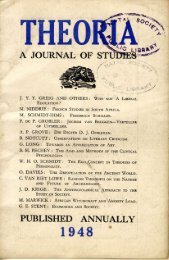Create successful ePaper yourself
Turn your PDF publications into a flip-book with our unique Google optimized e-Paper software.
An Important caveat needs to be wdi him. The<br />
argument that the contradict ions within and between<br />
the class forces organised by the NP qua part/ were<br />
transposed Into the Cabinet and especially Into the<br />
atata apparatuses themselves must not ba misunderstood.<br />
This is not to imply that these were the only, or<br />
•van the major struggles and contradictions within<br />
and between the state apparatus. The state has been<br />
defined ae % site of class struggle. The specifically<br />
Afrikaner nationalist struglles sere but part of,<br />
and indeed structured by end structuring of, alder<br />
class struggles,Thus a comprehensive analysis of<br />
the state would have to account for the Complex<br />
interaction between these various contradictory class<br />
forces and class struggles within the state.<br />
The point of this long analysis of the faction<br />
alism within the National Party and government is to<br />
situete Muldergate within the wider capitalist<br />
crisis. By late 1977, in the disastrous political<br />
aftermath of the defeat in Angola, the Soamto uprisings,<br />
the deeth of Steve Biko end the panicky banning of IB<br />
afrlcen politlcel and other organisations, confronted<br />
with increasingly organised and militant working class<br />
and mass resistance to Apartheid - a resistance now<br />
taking an openly anti-capitalist form - under severe<br />
international pressure from the Vast to introduce<br />
cosmetic changes, and faced with a massive outflow of<br />
foreign capital, huge unemployment and tha worst<br />
recession in South Africa's history, both the<br />
Nationalist government and Party themselves were<br />
decisively split over precisely the political<br />
questions posed by these multiple crises.<br />
The minutiae of these conflicts within both party<br />
and government could be elaborated if necessary. Hoe-<br />
aver, the point to note is thet in this period of<br />
intense crisis, the party end government were both<br />
effectively paralysed by their oen internal divisions.<br />
It must be emphasised as forcefully_a_s_is possible,<br />
that this mas no simple personality struggle, or<br />
purely ideological difference, but much_mjore profoundly<br />
a crisis of the class alliance on which Afrikaner<br />
nationalism had rested nationally and in tha various<br />
provinces since 19d8.<br />
To oversimplify for the sake of exposition, the<br />
'conservative 1 faction now grouped undar Uulder, and<br />
enjoying the strong tacit support of Vorster, were<br />
committed to retaining the alliance of farmers,<br />
businessmen, workers and petty bourgeoisie intact.<br />
To do so meant resisting moves to reform labour end<br />
industrial policy, end anything more than minimal<br />
concession* to the black middle class. Out it was<br />
equally clear that vmry few Afrikaner businessmen<br />
supported this policy with any enthusiasm. Rather,<br />
from within the Afrikaner business community, and<br />
amongst tha leading Afrikaner intellectuals there was<br />
now strong support for tha 'reformists* nf the party.<br />
This reflected the substantial development of<br />
Afrikaner business particularly in the Transvaal<br />
during the 1960s.^<br />
Thus, Sanlom and the Cape Party were no longer<br />
Isolated (as they hod been in the early 1960s) from<br />
powerful forces in the other provincial parties.<br />
The Transvaal party was now itself decisively<br />
divided along fairly explicit class lines between<br />
conservatives and reformists. The Transvaal leader,<br />
Or Connie Mulder, was the great hope of the conservative<br />
sing. But within the Transvmel Party there nom existed<br />
a powerful reformist opposition, grouped under two<br />
very influential Ministers * the Minister of nines<br />
and Planning, 0r p Koornhof, and tha Minister of<br />
Foreign Affairs, nr Botha. To Transvaal businessman<br />
Mulder was an anathema. One leading Afrikaner<br />
industrialist described him to me as e dpef - 'a fort*.<br />
By 1977 -a virtual politlcel impasse had been<br />
reached in party, cabinet end atata. Mot only was<br />
Vorster's Qonepertlem increasingly untenable within<br />
the party, but inside the Cabinet his practice of<br />
giving individual Hinletare their head made it ^mry<br />
difficult for him to recentrelise control in his own<br />
hands* He was thus unable to intervene decisively to<br />
give a particularly conservative or reformist<br />
direction to this government, but was reduced to the<br />
increasingly sterile role of trying simply to keep all<br />
factions together.<br />
After Angola end pmrticulerly Soweto, virtually<br />
all commentators were agreed thet on all the burning<br />
Issues of economic end political policy, behind the<br />
overt fece of hardline control, the government was<br />
virtually rudderless. Torn in many different B<br />
directions^ it spoke with many different voices. The<br />
political paralysis of the Vorster government when<br />
faced with severe end worsening economic and political<br />
crises, finally catalysed significant shifts in the<br />
alignment of political forces in the state. Tea<br />
groups are crucial hare - the military and the moat<br />
powerful of South Africa's capitalists. An alliance<br />
between these two forces rapidly took shape.<br />
whatever the fears of Afrikaner Intellectuals of<br />
a coup d'etat, senior military officers began to<br />
Intervene directly in these politlcel struggles over<br />
state polity, advocating significant reforms. In 19OT,<br />
through the Minister of Defence, Pi Botha, the military<br />
proclaimed ita programme of a 'total strategy' to meet<br />
the crises confronting the stete. Its fundamental aim<br />
according to the official military Journal, was 'a<br />
guarantee for the system) of trwm enterprise 1 .<br />
This could only be achieved on tha besls of a "coapre-<br />
hensive plan to utilise ell the means svailable to e<br />
state according to en integrated pattern*. Total<br />
strategy hald that 'the resolution bf a conflict In .<br />
the times in ehich we now live demands Interdependent<br />
and coordinated action in ell fields - military,<br />
psychological, economic, ideological, cultural etc<br />
... Ve are today involved in a war .*. the striving<br />
for specific elms ... must be coordinated aith all<br />
the means available to the state**<br />
bjut this 'coordinated action* should not be<br />
understood as simple defence of a static status quo.<br />
- political and economic reforms ware essential to<br />
ensure the defence of the state. In tha worde of the<br />
CJilef of Staffr<br />
The lesson is clear. The South African<br />
Defence force is reedy to beat off any attack<br />
•.. but ee muet take into account the aspirations<br />
of our different population groups, ee must «<br />
gain and keep their trust.<br />
In effect then, the Total Strategy Doctrine argued that<br />
'blacks* had to be given e stake in the capitalist<br />
system, whareby they would begin receiving the<br />
'beneflte' of that system, their 'quality of Ufe<<br />
would have to be Improved, thus supposedly giving


